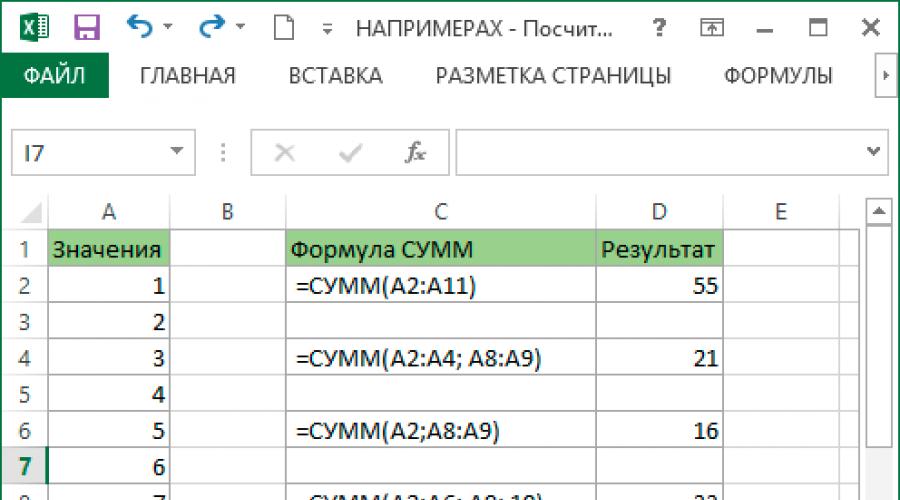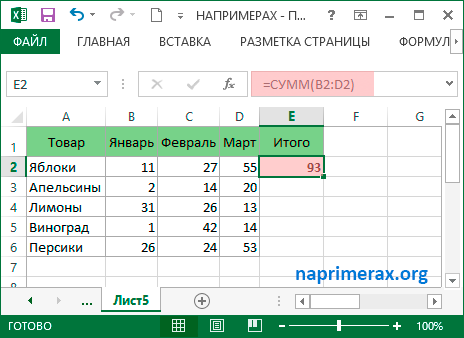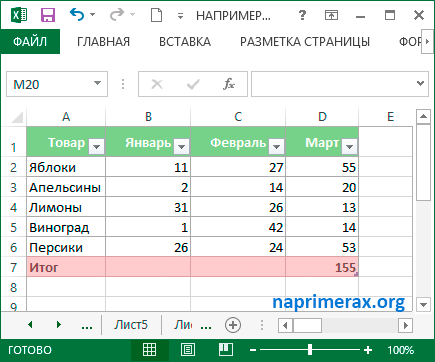Calculate sum in Excel

This article will look at how calculate sum in excel using the "AutoSum" function, as well as how to calculate sum in column, calculate the amount in a line or in a selected range using the SUM function. You will also learn how to sum only visible cells, count the total, how to calculate sum in excel on different sheets and much more.
Calculate the sum in Excel the fastest way
Let's take a look at the fastest way first. how to calculate sum of cells in excel. If you need to quickly figure out the sum of certain cells in Excel, simply select those cells and look at the status bar in the lower right corner of the Excel window:
Calculate the sum in Excel - A quick way to find out the sum of the selected cells
Well, let's start with the simplest ways. Therefore, even if you are new to Excel, it is unlikely that you will find it difficult to understand the following examples.
Calculate sum in Excel using simple arithmetic calculation
If you require calculate the sum of the cells, you can use Excel as a mini calculator. Just use the plus sign (+) operator as you would in a normal addition arithmetic operation. For example:
=1+2+3
or
=A1+C1+D1

Calculate the sum in Excel - Calculate the sum of cells with a simple arithmetic calculation
Of course, if you need to calculate the sum of several tens or several hundred rows, referring to each cell in the formula is not the best idea. In this case, you should use the SUM function, which is specially designed to add a specified set of numbers.
Calculate the sum in Excel using the SUM function
The SUM function is one of the mathematical and trigonometric functions that adds up values. The syntax for this function is as follows:
SUM(number1,[number2],…)
The first argument (number1 ) is required, the other numbers are optional, and you can specify up to 255 numbers in one formula.
In a SUM formula, any argument can be a positive or negative numeric value, a range, or a cell reference. For example:
SUM(A1:A100)
SUM(A1; A2; A5)
SUM(1;5;-2)
The SUM function is useful when you need to sum values from different ranges or combine numeric values, cell references, and ranges. For example:
SUM(A2:A4; A8:A9)
SUM(A2:A6, A9, 10)
The image below shows these and a few more examples of the SUM formula:

Calculate the sum in Excel - Examples of calculating the sum using the SUM formula
How to automatically calculate the amount in Excel
If you need automatically calculate the amount, sum a single range of numbers, whether it's the sum of a column, a row, or multiple adjacent columns or rows, you can let Microsoft Excel do those calculations for you.
Just select the cell next to the numbers you want to calculate the sum of, on the tab " HOME"In the group" Editing", Press" AutoSum"And the key" Enter"And you will have the formula" SUM»:

Calculate Sum in Excel - Calculate Sum in Column Using AutoSum
As you can see " AutoSum" Excel not only enters the SUM formula, but also selects the most likely range of cells to calculate the sum. In this case Excel will calculate the sum in the column automatically. If you need to adjust the suggested range, then you can manually correct it by simply dragging the cursor over the cells you want to count and then pressing the Enter key.
In addition to calculating the sum, you can use AutoSum to automatically enter the AVERAGE, COUNT, MAX or MIN functions. For more information, see the article "".
How to calculate the sum in a column in Excel
SUM(B2:B8)

Calculate Sum in Excel - Calculate Sum in Column
How to calculate the sum in a row in Excel
SUM(B2:D2)

Calculate Sum in Excel - Calculate Sum in Row in Excel

Calculate the sum in Excel - Calculate the sum in the Excel table using the total row
How to calculate the sum in Excel on different sheets
If you have multiple sheets with the same layout and the same data type, you can calculate the amount in the same cell or in the same range of cells on different worksheets with the same SUM formula.
SUM(January:March!B2)
SUM(January:March!B2:B8)
The first formula will calculate the sum of the values in cells B2, and the second formula will calculate the sum in the range B2:B8 in all sheets located between the specified two border sheets (January and March in this example):

Calculate Sum in Excel - Using a 3D reference to calculate the sum of identical cells or ranges between specified sheets
Thus, using the formula =SUM(January:March!B2) we calculated the sum of all apple sales values for three months. And with the help of the second formula =SUM(January:March!B2:B8) we found out the sum of sales of all goods for three months, the data of which were on different sheets. So you can calculate sum in excel on different sheets using formulas with 3D references.
That's all. Thank you for reading the article, and I hope that this article has sufficiently exhaustively revealed the question of how calculate sum in excel.